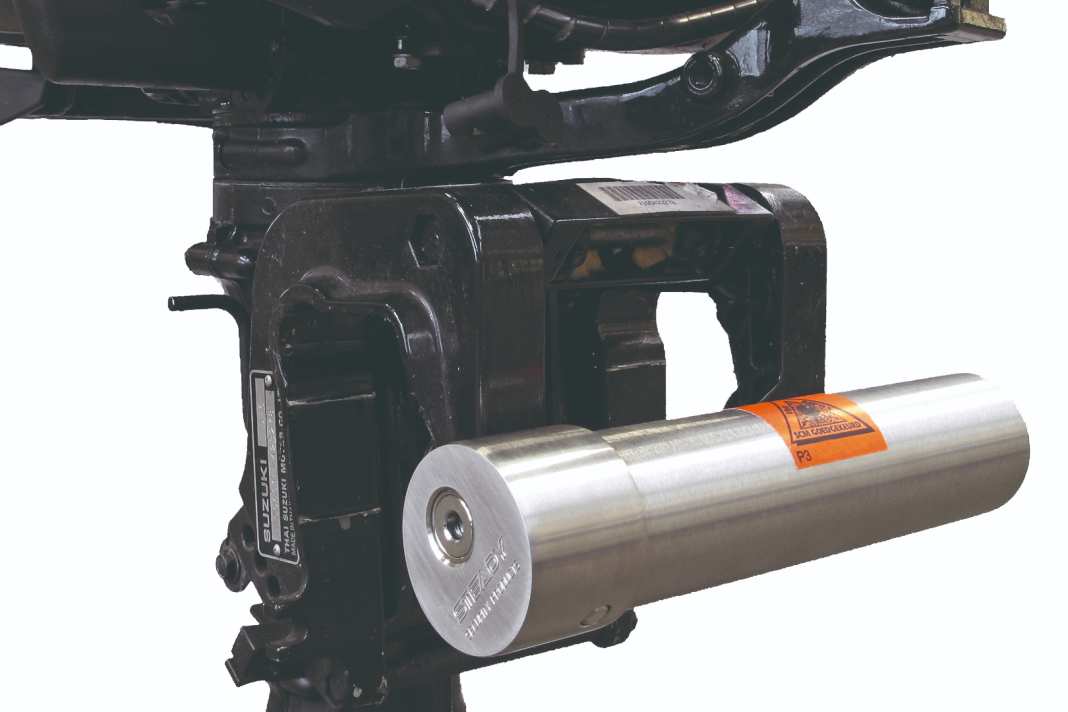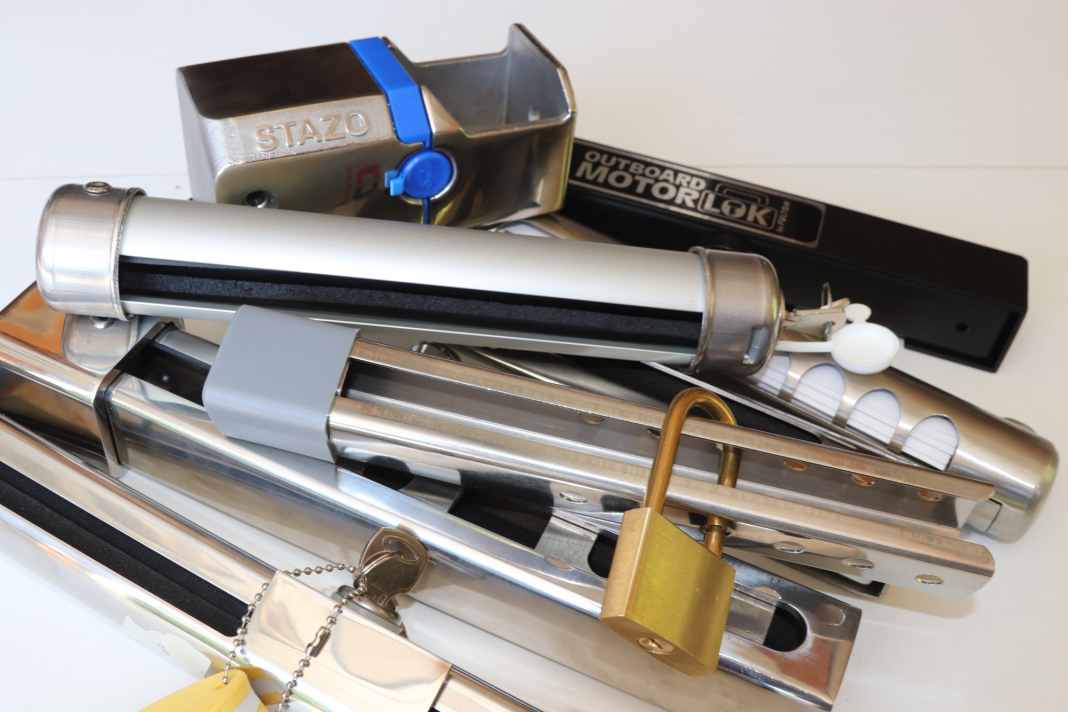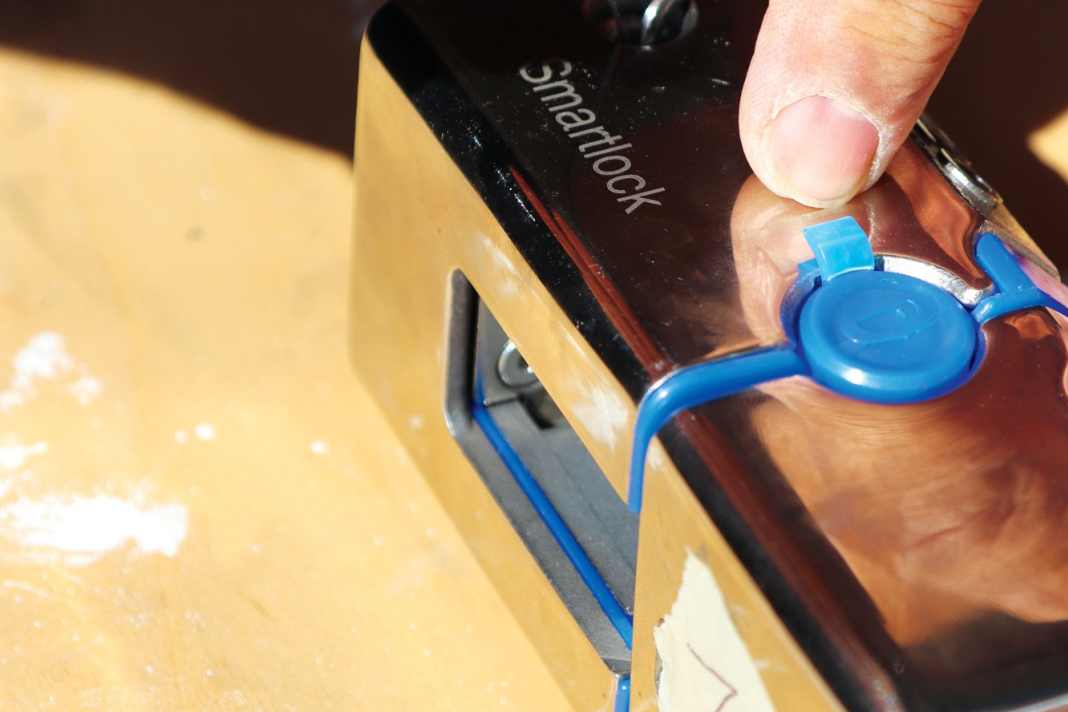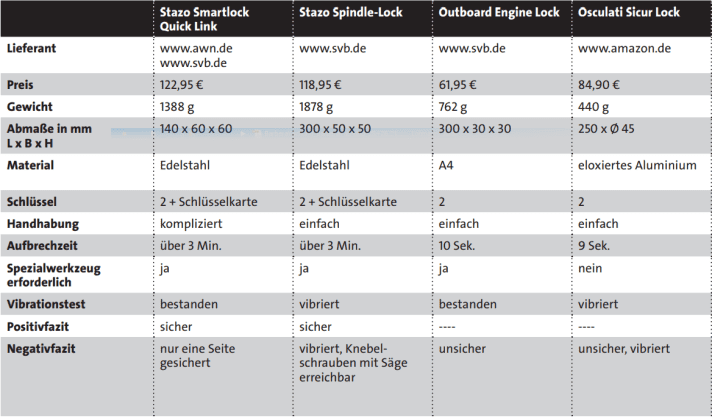



It is beautifully designed, it is secure, it is cleverly constructed. And so the lock for outboard motors from Steady would actually be worth an unreserved recommendation after the YACHT test - if it hadn't shown surprisingly strong signs of corrosion after just two months of use on the not particularly salty Baltic Sea.
The locking cylinder and the stainless steel sleeve that holds the outboard motor's fixing toggle were oozing an unsightly rusting liquid that was also staining the GRP of the transom. The inside of the sleeve was extensively affected. But the real problem lay elsewhere.
An iron detail causes traces of rust
In order to secure the toggles used to tighten the motor to its mount without rattling, a sheet of metal around two millimetres thick is first slid over them. This is coated with a thick layer of plastic to protect it from corrosion. However, the plate is made of simple iron, not stainless steel like the rest of the lock.
Because the stainless steel sleeve has sharp-edged burrs on the milled slots and is also unmachined on the inside, i.e. very rough, the plastic coating of the security plate can easily be damaged over time - as was the case in our long-term test. Although this does not directly compromise the anti-theft protection, it does result in unsightly rust marks. Changing the material of the insert plate from iron to stainless steel would make the Steady one of the best locks on the market. Price for the model up to 10 hp: around 100 euros.
Eight more outboard motor locks in the test
Our colleagues from BOOTE recently subjected eight other motorised locks to a major practical test. The question arose as to whether expensive is also good? To get to the bottom of the matter, they pitted locks from Stazo, one of SVB's own brands, Osculati, Atlantis, Yctze, Trem and Fulton against each other. The cheapest lock costs around 21 euros, the most expensive is around 123 euros. All test locks are slid over the tommy screws. The Stazo Smartlock Quick Link is the only one that only covers one tommy screw.
These outboard motor locks were tested:






Outboard motor locks in the test
As there are no prescribed test criteria for outboard motor locks, the colleagues decided to set an upper time limit for picking the locks. If a thief has unlimited time and tool resources at his disposal, any lock can be picked by professionals. For this reason, they also set a tool limit for this test. In addition to the three minutes of time, our "test thief", a former employee of a locksmith, initially only had access to normal manual tools that can be found in any hobby workshop.
As the noise level of electric tools such as cordless flex or jigsaws is very high, these were ruled out. Anyone sawing a lock at night in the harbour with a cordless flex saw automatically attracts attention and is very likely to be caught.
It must therefore be possible to open it quietly and with simple tools. Many thieves use so-called pick sets to open locks. They are available to everyone on the internet and, according to the "test thief", many simple locks can be opened with a little skill and practice. We will neither describe nor show the working methods used to pick the locks in detail here, so as not to teach budding thieves. In the test tables, we only indicate whether the locks could be opened and in what time. We differentiated between two categories: firstly, the use of conventional tools and secondly, the use of special tools such as the aforementioned pick set.
Stazo locks last a long time
It all started with the locks from Stazo. They are available from the well-known accessory dealers A. W. Niemeyer and SVB in Bremen. At 1380 g and 1880 g respectively, both locks were the heaviest in our test and also made the most valuable impression on our testers. However, this is also reflected in the price. Both locks cost around 120 euros each. They are made of stainless steel and both have two keys and a key card so that a key can be easily reordered if lost. In our test, it was not possible to break open the Stazo locks without special tools. Even after the maximum prescribed time of three minutes, we were unable to open either lock without causing massive damage to the engine or the rear of the boat.
The Stazo Smartlock Quick Link is the only one of the locks tested that does not slide over both tommy screws. It is mounted between the mirror and the tommy screw, so only one tommy screw can be secured. Installation is somewhat more complicated than with the simple locks, and the lock does not come with any installation instructions. These can only be found on the Internet; a shortcoming in our eyes. The tommy screw must point vertically downwards, making it difficult to tighten the screw one hundred per cent. On a positive note, the lock is well made and therefore does not make any noise when the motor vibrates.






Picking bad locks in two seconds
Installation is the same for all other locks tested. They are slid over the tommy screws and secured with a lock. The Trem lock performed the worst in the break-open tests. It took just two seconds to break open without special tools. The Osculati lock was hardly any better, with a break-open time of less than ten seconds. Both could be opened with simple tools and without physical effort.
Apart from the two Stazo locks, we only had significantly more difficulties with the outboard motor lock from Vinz. It made a high-quality impression and could not be opened within the specified time in our test either.
In terms of vibrations while riding, only the Stazo Smartlock and the Outboard Engine Lock from SVB performed well. All other locks can produce a loud and unpleasant rattling or clattering noise due to engine vibrations, which are particularly common on two-stroke engines and can be annoying on longer trips.
Who has the best price-performance ratio?
In addition to the security they offer, our test locks differed primarily in terms of installation and price. If you value simple installation and a reasonable price, the Vinz-Atlantis is the best choice. Installation is simple and instructions are included. In our test, the lock could not be opened using simple aids or special tools, nor by brute force. At the time of our test, it cost 89.99 euros on Amazon. Shipping and ordering were simple and straightforward. The delivery time was just as quick.
If you want to play it safe and are happy to spend a little more money, we would recommend the Stazo Smartlock Quick Link. It is at least as secure as the Vinz Atlantis outboard lock, but does not vibrate while riding due to its design. It is also possible to connect an extra security cable, which can be used to secure an additional outboard motor or to connect the boat to the jetty. At €122.95 from AWN or SVB, it is the most expensive in our test field. However, it is also the best lock in our test because it allows little to no vibration and is secure against special tools and normal aids.
The test result
The conclusion of our test is: more expensive is better - even when it comes to locks for outboards. All inexpensive test locks had more or less shortcomings, either in terms of handling, workmanship or security.



